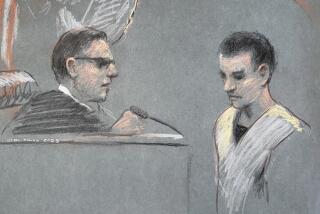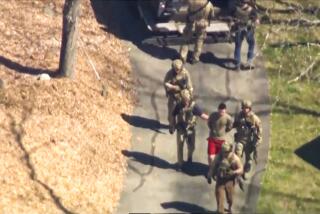Spy Case Jury Gets Look at Military Secrets Scrambler
- Share via
SAN FRANCISCO — Prosecutors wheeled into court Tuesday a classified military computer in a dramatic illustration of the secrets accused spy Jerry A. Whitworth is charged with transmitting to the Soviet Union.
The computer is used to scramble and unscramble U.S. secret military messages, and Whitworth, a retired Navy radioman, is accused of stealing and selling diagrams that would allow the Soviets to recreate the machine.
Earl D. Clark Jr., who spent more than three decades with the highly secretive National Security Agency, which designed the computer, testified that the box, while not impressive at first glance, is a vital link in the nation’s sophisticated system of secret communications.
“As you can see, we don’t make them sexy, but they do provide a sexy function,” Clark said of the box that has plugs, dials and a slot into which encoding key cards are fed.
The testimony came in the second day of Whitworth’s trial. Whitworth, 46, is accused of working for nine years as a key member of a ring headed by John A. Walker Jr., himself a former Navy radioman. Federal authorities have described the spy ring as the most damaging to operate against the United States in 30 years.
Prosecutors spent the entire day without mentioning Whitworth’s name. Instead, using witnesses, Rear Adm. Laurence Layman, in charge of communications for the Navy, and Clark, who held a series of highly sensitive posts for the NSA, prosecutors portrayed for jurors the intricate system used to keep sensitive information away from the Soviet Union and other hostile nations.
Layman testified about the satellite system that transmits messages to Navy vessels. Clark followed him by explaining the NSA-created system of cryptography that encodes and decodes those messages.
However, regardless of the system’s complexity, Clark testified, the one weak link remains someone who sells out to the enemy. Virtually any of the nation’s secrets could be revealed by a single “cognizant agent,” a person who knows the system, has a security clearance but works for the enemy, Clark said.
“Give me access to your codes, give me access to your ciphers and I have access to all your secrets. . . . You can’t place a value on it,” Clark said in rare public testimony by a security agency official.
“It protects all the other critical secrets of a nation,” Clark added.
Whitworth is accused of leaking to Walker, for sale to the Soviets, the two main elements of that code system--diagrams that can be used to reconstruct the computers that encode and decode secret military messages and the key cards that are fed into the computers and provide the particular code sequence used for a single day’s operation. Taken together, the two types of material would allow Soviets to listen freely to U.S. communications, Clark said.
The computer diagrams that Whitworth is accused of passing along to Walker depict the machine’s inner workings and are “more valuable than the machine itself,” Clark said. The diagrams, used by repair technicians, could be used to recreate a similar machine in a “relatively short period of time.”
The National Security Agency is responsible for creating communications systems of codes, computers and keys to encode and decode messages for virtually the entire federal government--from the White House to the military, State Department, CIA, FBI and Treasury Department.
Whitworth, who quit the Navy in 1983, was a communications specialist and at several posts was custodian of communications records, including the keys used in unlocking daily codes, and manuals used for repairing the machines.
In addition to several espionage counts, Whitworth is charged with income tax violations for allegedly receiving $332,000 for passing documents over a nine-year period.
Testimony was expected to continue today in U.S. District Judge John Vukasin’s courtroom, with witnesses telling jurors of Whitworth’s specific duties.
More to Read
Sign up for Essential California
The most important California stories and recommendations in your inbox every morning.
You may occasionally receive promotional content from the Los Angeles Times.













